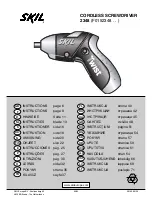
Cordless Tool
22
Charger
Minimum Gauge for Cord Sets
Ampere Rating
Volts
Total Length of Cord in Feet (meters)
120V
25 (7.6)
50 (15.2)
100 (30.5)
150 (45.7)
240V
50 (15.2)
100 (30.5)
200 (61.0)
300 (91.4)
More
Than
Not More
Than
AWG
0
6
18
16
16
14
6
10
18
16
14
12
10
12
16
16
14
12
12
16
14
12
Not Recommended
Do not place any object on top of the charger or place the charger on a soft surface that might block the ventilation
slots and result in excessive internal heat. Place the charger in a position away from any heat source. The charger
is ventilated through slots in the top and the bottom of the housing.
Do not operate the charger with a damaged cord or plug.
Do not operate the charger if it has received a sharp blow, been dropped or otherwise damaged in any way. Take
it to an authorized service center.
Do not disassemble the charger; take it to an authorized service center when service or repair is required. Incorrect
reassembly may result in a risk of electric shock, electrocution or fire.
Disconnect the charger from the outlet before attempting any cleaning. This will reduce the risk of electric shock.
Removing the battery pack will not reduce this risk.
NEVER attempt to connect 2 chargers together.
The charger is designed to operate on standard 120V household electrical power. Do not attempt to use it on any
other voltage.
2.2.2
Regulatory Notices for Charger
It is mandatory that national, state and local codes and standards be followed.
2.2.2.1
FCC Notice (USA)
This device complies with Part 15 of the FCC Rules. Operation is subject to the following two conditions: (1) this
device may not cause harmful interference, and (2) this device must accept any interference received, including
interference that may cause undesired operation.
This equipment has been tested and found to comply with the limits for a Class B digital device, pursuant to Part
15 of the FCC Rules. These limits are designed to provide reasonable protection against harmful interference
in a residential installation. This equipment generates, uses and can radiate radio frequency energy and, if not
installed and used in accordance with the instructions, may cause harmful interference to radio communications.
However, there is no guarantee that interference will not occur in a particular installation. If this equipment does
cause harmful interference to radio or television reception, which can be determined by turning the equipment
off and on, the user is encouraged to try to correct the interference by one or more of the following measures:
• reorient or relocate the receiving antenna,
• increase the separation between the equipment and receiver,
• connect the equipment into an outlet on a circuit different from that to which the receiver is connected, or
• consult the dealer or an experienced radio/TV technician for help.
2.2.2.2
Industry Canada Notice (Canada)
This Class B digital apparatus complies with Canadian ICES-003.
The term “IC” before the certification/registration number only signifies that the Industry Canada technical
specifications were met.
Le terme “IC” devant le numéro de certification /d’enregistrement signifie seulement que les
Summary of Contents for QPM CORDLESS TOOL
Page 5: ...Instruction Manual V Table of Contents 5 9 Return Material Authorization RMA Procedures 49...
Page 6: ......
Page 23: ...Instruction Manual 17 Introduction...
Page 24: ......
Page 38: ......
Page 48: ......
Page 49: ...Cordless Tools 4 Preventive Maintenance Calibration Repairs Cleaning Disposal Maintenance...
Page 52: ......
















































